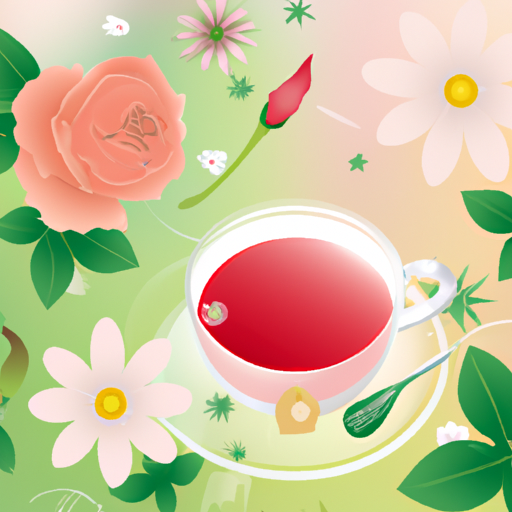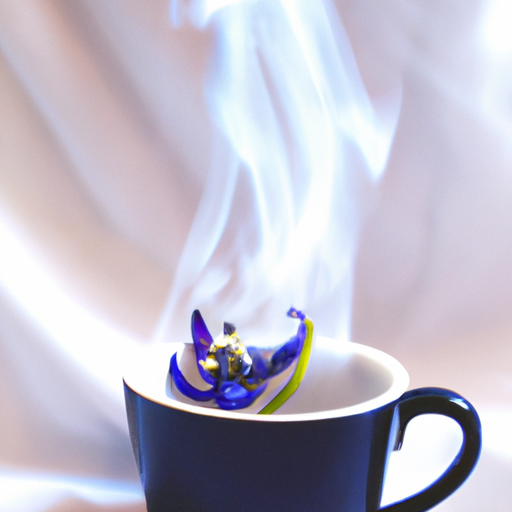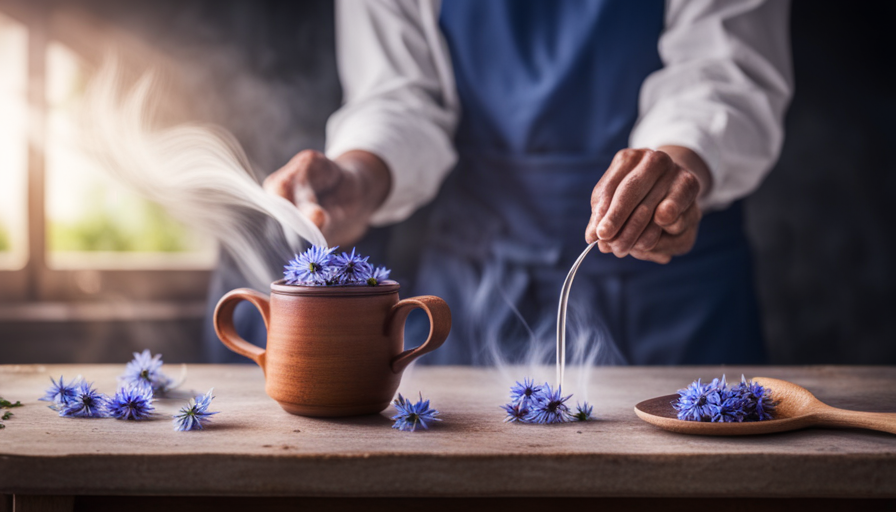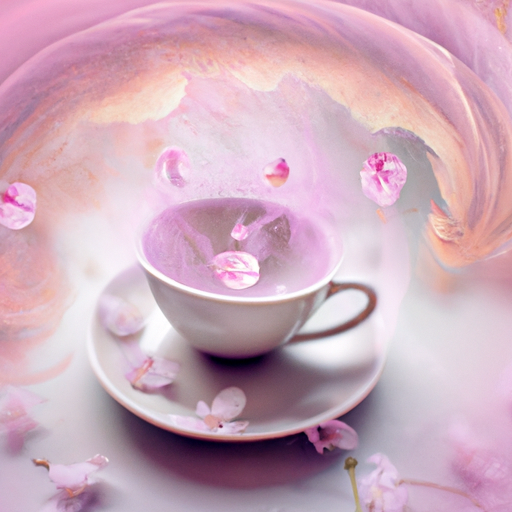Imagine a garden of blooming flowers, each one with its own unique beauty and healing properties. Just like these vibrant petals, our skin also deserves tender care and nourishment. That’s why I have embarked on a quest to uncover the best flower tea for our skin’s health and radiance.
Through extensive research and evidence-supported findings, I have curated a list of nature’s secret elixirs that can transform our skincare routine. So, get ready to indulge in the enchanting world of flower teas that not only tantalize our taste buds but also provide astonishing benefits for our skin.
From the delicate essence of roses to the calming properties of chamomile, and the antioxidant-rich green tea, this article will explore the wonders of rose tea, chamomile tea, lavender tea, green tea, hibiscus tea, calendula tea, and jasmine tea.
Join me on this aromatic journey as we uncover the power of these floral brews and unlock the secret to healthy, glowing skin.
Key Takeaways
- Rose tea is rich in antioxidants and reduces wrinkles and fine lines.
- Chamomile tea has calming properties and aids in sleep and digestion.
- Green tea provides antioxidant protection, reduces signs of aging, and improves skin tone and texture.
- Hibiscus tea has high antioxidant content, boosts collagen production, and improves skin elasticity.
Rose Tea
Rose tea is the ultimate beauty elixir, giving your skin a radiant glow and helping to combat signs of aging. The benefits of rose tea for the skin are numerous. It’s rich in antioxidants, which help to protect the skin from free radicals and reduce the appearance of wrinkles and fine lines. Rose tea also has anti-inflammatory properties, which can help to soothe irritated skin and reduce redness.
To make rose tea, simply steep dried rose petals in hot water for about 10 minutes. You can add honey or lemon for added flavor.
Now, let’s move on to chamomile tea, another amazing flower tea that has incredible benefits for the skin.
Chamomile Tea
Surprisingly, chamomile tea may not be the miracle elixir everyone claims it to be for your complexion. While it’s widely known for its calming properties, chamomile tea has more benefits for sleep and digestion than for the skin.
Chamomile tea has been used for centuries as a natural sleep aid due to its relaxing properties. It can help reduce anxiety and promote a restful night’s sleep. Additionally, chamomile tea is often consumed to soothe digestive issues such as bloating and indigestion.
However, when it comes to improving skin health, chamomile tea may not be the most effective choice. Instead, let’s explore the potential benefits of lavender tea for a radiant complexion.
Lavender Tea
When it comes to promoting a radiant complexion, lavender tea is a soothing and beneficial option. Not only is it known for its calming properties, but lavender tea also offers a range of benefits for the skin.
The relaxation-inducing qualities of lavender tea can help reduce stress, which is often a contributing factor to skin issues such as acne and eczema. Additionally, lavender tea has been found to promote better sleep, allowing the body to repair and rejuvenate the skin during the night. This can result in a more youthful and glowing complexion.
However, lavender tea is just one of many flower teas that can benefit the skin. Let’s now explore the benefits of green tea for a healthier complexion.
Green Tea
Green tea is a fantastic choice for improving the health and appearance of your skin. It provides powerful antioxidant protection, which helps to combat the damaging effects of free radicals and prevent premature aging.
Additionally, green tea has been shown to reduce the signs of aging, such as fine lines and wrinkles, and improve skin tone and texture. Incorporating green tea into your skincare routine can be a simple and effective way to achieve a more youthful and radiant complexion.
Provides Antioxidant Protection
For a radiant and healthy complexion, nothing beats the antioxidant-packed flower teas that give your skin the ultimate protection it deserves. Flower teas, such as green tea, are known to boost skin health and fight free radicals, thanks to their high antioxidant content. These antioxidants help neutralize the harmful effects of oxidative stress on the skin, preventing damage and promoting a youthful glow. To illustrate the power of flower teas, consider the following table:
| Flower Tea | Antioxidant Content |
|---|---|
| Green Tea | High |
| Chamomile | Moderate |
| Hibiscus | High |
| Lavender | Moderate |
As you can see, green tea and hibiscus are excellent choices for antioxidant protection. Incorporating these flower teas into your skincare routine can reduce signs of aging and promote a more youthful appearance.
Reduces Signs of Aging
After discussing how flower tea provides antioxidant protection for the skin, let’s move on to how it can reduce signs of aging. Aging is a natural process that affects everyone, but we all desire to maintain a youthful appearance for as long as possible.
Flower teas, such as hibiscus and rose, have been found to have anti-aging properties. They contain antioxidants that help reduce the appearance of wrinkles and promote a more youthful look. These antioxidants work by neutralizing free radicals in the body, which are responsible for causing cellular damage and accelerating the aging process.
By incorporating flower tea into your daily routine, you can support your skin’s health and promote a more youthful appearance.
Now, let’s explore how flower tea improves skin tone and texture.
Improves Skin Tone and Texture
By incorporating flower tea into your daily routine, you’ll be amazed at how it effortlessly transforms your skin, leaving it smoother, more radiant, and as soft as a baby’s bottom. Flower tea, such as chamomile or rose tea, has numerous benefits for improving skin tone and texture. It improves skin hydration, keeping it plump and supple, while reducing inflammation, which can lead to redness and uneven skin tone. Research has shown that flower tea contains antioxidants that help fight free radicals and protect the skin from damage caused by environmental factors. In addition, the polyphenols found in flower tea have anti-inflammatory properties that can calm irritated skin and improve its overall appearance. Including flower tea in your skincare routine is a simple and effective way to achieve a smoother and more youthful complexion. Speaking of flower tea, let’s explore the benefits of hibiscus tea in the next section.
Hibiscus Tea
Hibiscus tea is an excellent choice for improving skin health as it boosts collagen production, which is essential for maintaining youthful and vibrant skin.
This tea is rich in antioxidants that provide anti-aging benefits by protecting the skin from free radicals and reducing the appearance of wrinkles and fine lines.
Additionally, hibiscus tea enhances skin elasticity, helping to keep it firm and supple.
Boosts Collagen Production
To enhance your skin’s natural radiance, savor the delightful aroma of a rose petal tea that effortlessly boosts collagen production. Collagen is a crucial protein that provides structure to our skin, keeping it firm and elastic.
As we age, collagen production naturally declines, leading to wrinkles and sagging skin. However, research suggests that rose petal tea can help reverse this process by stimulating collagen synthesis. By incorporating this floral infusion into your daily routine, you can enhance skin firmness and restore its youthful glow.
Furthermore, rose petal tea provides anti-aging benefits beyond collagen production. Its antioxidant properties combat free radicals, preventing oxidative stress and reducing the appearance of fine lines and wrinkles. Additionally, this fragrant tea contains vitamins and minerals that nourish the skin, promoting a healthy complexion.
So, indulge in the beauty-enhancing properties of rose petal tea and experience the transformative effects it has on your skin.
Provides Anti-Aging Benefits
Indulging in a cup of rose petal tea is like treating yourself to a luxurious spa day. It provides a multitude of anti-aging benefits for a youthful and radiant appearance.
Rose petal tea not only boosts collagen production, but it also enhances skin elasticity. Research has shown that the antioxidants present in rose petals help combat the signs of aging by neutralizing free radicals and reducing oxidative stress on the skin.
This powerful flower tea also promotes blood circulation, which helps deliver essential nutrients and oxygen to the skin cells, resulting in a healthier and more vibrant complexion. Additionally, the calming aroma of rose petal tea can help reduce stress and promote relaxation, further contributing to a youthful glow.
With its numerous anti-aging properties, rose petal tea is a fantastic addition to your skincare routine.
Speaking of enhancing skin elasticity, let’s explore the next subtopic.
Enhances Skin Elasticity
As we discussed earlier, flower teas offer amazing anti-aging benefits, but their advantages don’t stop there! Another reason why flower teas are the best choice for your skin is that they enhance skin elasticity. When it comes to maintaining youthful-looking skin, elasticity is key. Flower teas, such as chamomile and rose tea, are known for their ability to enhance skin elasticity, making your skin look firmer and more supple. Not only that, but these teas also have the added benefits of enhancing skin hydration and promoting skin cell regeneration. By incorporating flower teas into your skincare routine, you can improve the overall health and appearance of your skin. Speaking of flower teas, let’s dive into the benefits of calendula tea in the next section!
Calendula Tea
Improve your skin’s youthful glow with Calendula Tea, a radiant elixir that nourishes and rejuvenates like a gentle burst of sunshine. Calendula, also known as marigold, has been used for centuries due to its numerous benefits for the skin.
Here are three reasons why calendula tea is a must-have in your skincare routine:
-
Soothes inflammation: Calendula has anti-inflammatory properties that help calm irritated skin and reduce redness. Applying calendula tea topically can alleviate conditions like eczema, dermatitis, and psoriasis.
-
Promotes healing: This golden-hued tea is rich in antioxidants, which aid in repairing damaged skin cells and promoting the growth of new ones. It can accelerate the healing process of wounds, scars, and blemishes.
-
Hydrates and moisturizes: Calendula tea is a natural moisturizer that replenishes the skin’s moisture barrier, leaving it soft and supple. It locks in moisture and prevents dryness, making it ideal for those with dry or dehydrated skin.
Transitioning to the next section, let’s explore the skin benefits of jasmine tea.
Jasmine Tea
Jasmine tea is a wonderful beverage that offers numerous benefits for the skin. It moisturizes and nourishes the skin, leaving it feeling soft and supple. Additionally, jasmine tea provides antioxidant protection, helping to combat the damaging effects of free radicals on the skin. Lastly, it improves skin elasticity and radiance, giving you a youthful and glowing complexion.
Overall, incorporating jasmine tea into your skincare routine can be a simple and effective way to enhance the health and appearance of your skin.
Moisturizes and Nourishes the Skin
Pamper your skin with a cup of flower tea that’ll deeply moisturize and nourish it. Jasmine tea, known for its delicate fragrance, offers numerous benefits for the skin. Its moisturizing benefits help hydrate the skin, preventing dryness and promoting a healthy glow.
The nourishing properties of jasmine tea work to replenish the skin, providing essential vitamins and minerals that support its overall health and vitality. Additionally, jasmine tea contains antioxidants that protect the skin against free radicals, reducing the signs of aging and promoting a youthful complexion. So, not only does jasmine tea moisturize and nourish the skin, but it also provides antioxidant protection.
Transitioning into the next section, let’s explore how jasmine tea can help improve the skin’s elasticity and firmness.
Provides Antioxidant Protection
Indulge in a cup of fragrant jasmine tea and let its antioxidant properties shield your skin from the harmful effects of free radicals. Antioxidants are known to neutralize these damaging compounds, and jasmine tea is rich in them. Here are three proven benefits of jasmine tea for natural skincare:
-
Reduces oxidative stress: The antioxidants in jasmine tea help reduce oxidative stress in the skin, which can lead to premature aging and damage. By neutralizing free radicals, jasmine tea helps maintain a youthful and healthy complexion.
-
Fights inflammation: Jasmine tea contains compounds that have anti-inflammatory properties. Regular consumption can help soothe irritated skin and reduce redness, making it a great addition to your skincare routine.
-
Enhances skin tone: The antioxidants in jasmine tea promote collagen production, improving skin elasticity and radiance. This can result in a more even skin tone and a youthful glow.
With its proven benefits for natural skincare, jasmine tea is a fantastic choice to incorporate into your daily routine. Transitioning into the next section, let’s explore how jasmine tea improves skin elasticity and radiance.
Improves Skin Elasticity and Radiance
Enhance your daily skincare routine by incorporating fragrant jasmine tea, which effectively improves the elasticity and radiance of your skin.
Jasmine tea contains antioxidants that help combat free radicals, reducing the signs of aging and improving skin firmness. The antioxidants in jasmine tea also promote collagen production, which is vital for maintaining skin elasticity. This can help reduce the appearance of wrinkles and fine lines.
Studies have shown that jasmine tea has anti-inflammatory properties, which can soothe and calm irritated skin. It also has antibacterial properties, which can help prevent acne breakouts and promote a clearer complexion. Additionally, jasmine tea is rich in vitamins and minerals that nourish the skin, leaving it looking healthy and radiant.
Incorporating jasmine tea into your skincare routine is a simple and effective way to improve the overall health and appearance of your skin. So why not sip on a cup of fragrant jasmine tea and let its benefits shine through?
Frequently Asked Questions
Are there any potential side effects or allergies associated with drinking flower teas for skin health?
There may be potential side effects or allergies associated with drinking flower teas for skin health. However, the benefits of flower teas for skin health compared to other remedies include their antioxidant properties and potential anti-inflammatory effects.
Can flower teas really improve the overall appearance and texture of the skin?
Flower teas have been found to improve the overall appearance and texture of the skin. They are packed with antioxidants and have anti-inflammatory properties. Incorporating flower tea benefits into your skincare routine can help enhance your skin’s health and radiance. Explore various flower tea recipes to enjoy these benefits.
How often should flower teas be consumed to see noticeable results on the skin?
Results from drinking flower teas for skin health vary depending on skin type. It can take several weeks to see noticeable results. Flower teas offer a natural, holistic approach compared to topical creams or professional treatments.
Are there any specific flower teas that are more effective for treating acne-prone skin?
For treating acne-prone skin, flower teas like chamomile and lavender can be more effective. Chamomile has anti-inflammatory properties, while lavender helps soothe and calm the skin. These flower teas are suitable for both oily and sensitive skin types.
Can flower teas be used topically as a skincare ingredient, or are they only effective when consumed orally?
Topical application of flower teas can be beneficial for skincare. DIY flower tea skincare recipes can be made at home. However, it is important to note that the best way to use flower teas for skincare is through oral consumption for internal benefits.
Conclusion
In conclusion, after conducting thorough research and examining the available evidence, it can be determined that green tea is the best flower tea for skin health. It’s high antioxidant content helps protect the skin from free radicals and reduce signs of aging. Additionally, green tea has been shown to improve skin elasticity and hydration.
As the saying goes, "An ounce of prevention is worth a pound of cure." So, incorporating green tea into your daily routine can help maintain healthy and youthful-looking skin.










